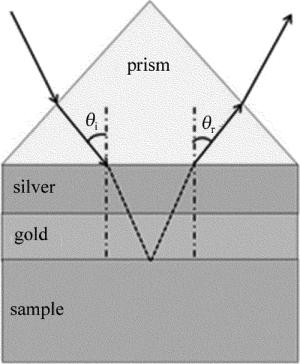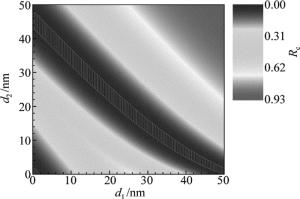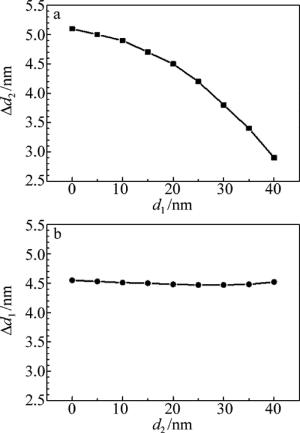HTML
-
自1983年NYLANDER首次将Kretschmann棱镜耦合型表面等离子体共振(surface plasmon resonance, SPR)传感器应用于生物分子检测[1],棱镜型SPR传感器以其灵敏度高和可实时检测等优点在生物医药、食品安全、物理化学、环境检测等领域[2-4]得到了广泛关注。而作为描述传感器特性的重要参量,灵敏度一直是棱镜型SPR传感器特性研究的热点。
棱镜型SPR传感器的灵敏度一般与传感器结构参量(如棱镜折射率、金属介电常数和厚度)及入射条件(如入射光波长)有关。研究表明,棱镜折射率越低,SPR传感器灵敏度越高[5]。金属介电常数为纯虚数时表面等离子波耦合作用最强,并且对于每个入射光波长,金属厚度存在一个最佳值[6]。在特定波长范围内,入射光波长越小,SPR传感器灵敏度越高[7]。近期研究发现,通过改变SPR传感器的结构可以提高灵敏度。如周期性金属结构[8]、光栅结构[9]、光纤结构[10]以及在金属表面加载介质层构成波导结构等均可实现灵敏度的提高[11-12]。2008年, ABDULHALIM等人发现在金属层上加载硅介质可以提高传感器的灵敏度[13],并于2010年通过计算多层膜的场分布,解释了灵敏度提高的物理机制[14]。
银-金双金属层结构SPR传感器通过在银薄膜表面上增镀金薄膜,可使SPR传感器同时具有单层银膜传感器高分辨率以及单层金膜传感器稳定化学特性的优点。2002年, WU等人分析比较了单层银膜、单层金膜和双金属结构的灵敏度特性[15]。2006年, ONG和YUAN等人通过优化金属层的厚度,从理论和实验上证实了双金属层结构可获得较高的灵敏度和结构稳定性[16-17]。2011年, CHEN等人发现将银-金双金属层应用于商业SPR仪器中,获得了更高的品质因子以及更稳定的性能[18]。2014年, KIM等人在银-金双金属层上加入周期性小孔研制了一种完美吸收的表面等离子体晶体结构传感器[19]。但目前为止,对双金属层结构SPR传感器灵敏度随金属厚度变化的规律研究尚鲜见相关报道。
本文中基于薄膜光学理论,首先通过分析银-金双金属层SPR传感器的反射率随银-金薄膜厚度的变化规律,得到了共振角处反射率小于0.01时银和金薄膜厚度的取值范围;其次,通过研究该厚度取值范围内传感器灵敏度的变化规律,提出了一种优化双金属结构SPR传感器灵敏度的方法。
-
双金属层SPR传感器的结构如图 1所示。考虑入射光波长为633nm的情况,BK7玻璃棱镜折射率n0= 1.51509,银膜的介电常数εAg=-17.81+0.676i[16],金膜的介电常数εAu=-10.98+1.464i,待测样品折射率为ns=1.33,图中θi与θr分别代表光波的入射角以及反射角。
根据薄膜光学理论,双金属层SPR传感器结构可视为图 2所示的等效双层膜模型,其中银膜的折射率和厚度分别为n1和d1,金膜的折射率和厚度分别为n2和d2。
考虑p偏振光入射的情况,基于菲涅耳公式,可得到入射界面与出射界面电场强度(E0与E3)及磁场强度(H0和H3)之间的关系式:
式中,${\delta _i} = \frac{{2{\rm{ \mathsf{ π} }}}}{\lambda }{n_i}{d_i}{\rm{cos}}{\theta _i}\left( {i = 1,2} \right)$, θi为第i层膜中的折射角,ηi=ni/cosθi为入射光在薄膜中的导纳。
由于入射介质的等效导纳Y=H0/E0,并且H3/E3= η3,则:
因此,双层膜系的特征矩阵可以写成:
式中, B与C为表征薄膜系统光学特性的参量。
而整个薄膜系统对入射光波的能量反射率为:
式中, η0是入射介质的导纳。
另外,在角度调制情况下,若θc代表SPR传感器最低反射率对应的角度(称为共振角),则传感器的灵敏度Sθ通常定义为共振角的变化值Δθc与样品折射率射率的变化值Δns的比值,即:
-
反射谱共振峰棱镜型SPR传感器实现有效检测的前提条件是表面等离子体共振峰明显,即共振峰峰值反射率尽可能小,因此,本文中首先研究了不同金属厚度下,银-金双金属层SPR传感器共振角处的反射率Rc,如图 3所示。其中银膜厚度d1和金膜厚度d2取值范围均为0nm~50nm。在保证共振峰峰值尽可能低(Rc < 0.01)的前提下,银-金双金属层厚度取值存在一个范围,如图 3中阴影部分所示, 代表Rc < 0.01的区域。
图 4为满足Rc < 0.01条件时,双金属层中金膜厚度取值带宽Δd2随银膜厚度d1的变化曲线以及双金属层中银膜厚度取值带宽Δd1随金膜厚度d2的变化曲线。由图可知,Δd2随银膜厚度d1的增大而减小,而Δd1随金膜厚度d2的增大几乎保持不变。例如,当d1从0nm增加到40nm时,Δd2从5.1nm减小到2.9nm; 而d2从0nm增加到40nm时,Δd1始终维持在4.5nm左右。
-
为了研究银-金双金属层传感器的灵敏度特性,本文中计算出了该结构传感器灵敏度随银膜厚度d1和金膜厚度d2变化的等高线图,如图 5所示。其中d1和d2的取值范围与图 3中一致,虚线框部分与图 3阴影部分一致,代表Rc < 0.01的薄膜厚度区域。

Figure 5. Contour map of sensitivity S of bimetallic film SPR sensor vs. thicknesses of Ag and Au films (d1-d2)
由图 5可知,当双金属层SPR传感器中金属薄膜厚度变化时,传感器灵敏度变化范围为:40°/RIU~170°/RIU(这里用°/RIU作为灵敏度的单位,它表示在1个折射率变化单位内共振角的变化值)。由于共振角处反射率越高SPR传感器性能越差,因此,仅考虑满足Rc < 0.01条件下传感器的灵敏度特性,即图 5中虚线框区域。从图 5虚线框区域可以看出,在同一银膜(或金膜)厚度下,传感器灵敏度随着金膜(或银膜)厚度的增加而升高(2°/RIU~5°/RIU),因此,可以通过选择Rc < 0.01虚线框区域部分上边缘线对应的双金属膜厚度值,提高双金属层SPR传感器的灵敏度。
图 6中给出了在样品折射率为1.325和1.335时,两种不同银-金薄膜厚度组合下双金属层SPR传感器的共振峰曲线。其中第1组银-金薄膜厚度组合为30nm~14.1nm(双金属层结构Ⅰ), 可实现共振角处反射率最小值。第2组取银膜厚度30nm时, 图 5中虚线框区域上边缘线对应的银-金厚度组合30nm~16.1nm(双金属层结构Ⅱ)。当折射率改变时,共振角的变化值如表 1所示。双金属层结构Ⅰ,当样品折射率从1.325变为1.335时,共振角从70.0096°变为了71.3538°,对应的灵敏度值为134.4231°/RIU; 双金属层结构Ⅱ,对应相同的样品折射率变化,共振角从70.275°变为71.6538°,对应的灵敏度为137.8846°/RIU。相比双金属层结构Ⅰ,双金属层结构Ⅱ的SPR传感器在保证共振峰反射率峰值小于0.01的前提下,通过适当提高金膜厚度,灵敏度提高了3.4615°/RIU。由此可见,在保证传感器低共振角反射率特性的前提下,可通过适当提高金属薄膜的厚度来提高传感器的灵敏度。

Figure 6. Relationship between reflectivity of bimetallic film SPR sensors and θ with two different thickness combinations
configurations θc, 1/(°) θc, 2/(°) Sθ/(°·RIU-1) bimetallic layer Ⅰ
(d1=30nm, d2=14.1nm)70.0096 71.3538 134.4231 bimetallic layer Ⅱ
(d1=30nm, d2=16.1nm)70.275 71.6538 137.8846 Table 1. θc and Sθ of two configurations
2.1. 双金属层厚度的优化
2.2. 双金属层SPR的灵敏度特性
-
在保证共振峰反射率Rc < 0.01前提下,银-金双金属层SPR传感器的银膜和金膜厚度取值存在一定的取值范围,并且金膜厚度的取值范围随着传感器中银膜厚度的增大而减小,而银膜厚度的取值范围随传感器中金膜厚度的增大几乎保持不变;同时,双金属层SPR传感器的灵敏度随金属薄膜(金膜与银膜)厚度的增加而提高。因此,可通过适当提高双金属层SPR传感器中的金属薄膜的厚度来实现其灵敏度的优化。

 Map
Map








 DownLoad:
DownLoad:




